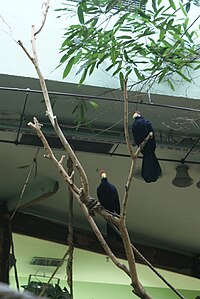Ross's turaco
[2] This species expresses very little sexual dimorphism, with both males and females being the same deep shade of blue with red head crowns and flight feathers.
Females can have slightly more yellow-green beaks while males always have a bright yellow, with both having a forehead shield that flares to a medium orange.
They generally avoid heavily forested areas and their numbers remain strong despite the threat of habitat destruction due to agriculture expansion.
They are occasionally kept as pets, though they are potentially hard to find; if chicks are not bred from captive parents, they may come from questionable or dubious sources.
On the contrary, captive-bred birds will naturally be accustomed to human care and presence, and hatch with an innate hardiness and friendlier personality.
Ross’s turaco are internationally found in zoos and botanical gardens, popular with visitors and keepers alike, due to their vivid colors, hardiness and calm disposition.

